Estimation of Propagation Speed and Direction of Nonlinear Internal Waves from Underway and Moored Measurements
Abstract
1. Introduction
2. Data and Methods
2.1. Data and Processing
2.2. Methods
2.2.1. Two-Layered KdV (Korteweg-de Vries) Theories
2.2.2. Doppler Shift Method
2.2.3. Time Lag Method
2.2.4. Estimation of Propagation Speed and Direction
2.2.5. Estimation of Propagation Direction Using Satellite Images
3. Applications
3.1. SAVEX15
3.2. IORS18
4. Discussion
5. Concluding Remarks
Author Contributions
Funding
Institutional Review Board Statement
Informed Consent Statement
Data Availability Statement
Acknowledgments
Conflicts of Interest
References
- MacKinnon, J.A.; Gregg, M.C. Mixing on the late-summer new England shelf-Solibores, shear, and stratification. J. Phys. Oceanogr. 2003, 33, 1476–1492. [Google Scholar] [CrossRef]
- Alford, M.H. Redistribution of energy available for ocean mixing by long-range propagation of internal waves. Nature 2003, 423, 159–162. [Google Scholar] [CrossRef] [PubMed]
- D’Asaro, E.A.; Lien, R.-C.; Henyey, F. High-Frequency Internal Waves on the Oregon Continental Shelf. J. Phys. Oceanogr. 2007, 37, 1956–1967. [Google Scholar] [CrossRef]
- Moum, J.N.; Farmer, D.M.; Shroyer, E.L.; Smyth, W.D.; Armi, L. Dissipative Losses in Nonlinear Internal Waves Propagating across the Continental Shelf. J. Phys. Oceanogr. 2007, 37, 1989–1995. [Google Scholar] [CrossRef]
- Shroyer, E.L.; Moum, J.N.; Nash, J.D. Mode 2 waves on the continental shelf: Ephemeral components of the nonlinear internal wavefield. J. Geophys. Res. Space Phys. 2010, 115. [Google Scholar] [CrossRef]
- Scotti, A.; Pineda, J. Plankton accumulation and transport in propagating nonlinear internal fronts. J. Mar. Res. 2007, 65, 117–145. [Google Scholar] [CrossRef]
- Muacho, S.; da Silva, J.; Brotas, V.; Oliveira, P. Effect of internal waves on near-surface chlorophyll concentration and primary production in the Nazaré Canyon (west of the Iberian Peninsula). Deep Sea Res. Part. I Oceanogr. Res. Pap. 2013, 81, 89–96. [Google Scholar] [CrossRef]
- Villamaña, M.; Mourino-Carballido, B.; Marañón, E.; Cermeno, P.; Chouciño, P.; da Silva, J.C.B.; Díaz, P.; Castro, B.F.; Gilcoto, M.; Graña, R.; et al. Role of internal waves on mixing, nutrient supply and phytoplankton community structure during spring and neap tides in the upwelling ecosystem of Ría de Vigo (NW Iberian Peninsula). Limnol. Oceanogr. 2017, 62, 1014–1030. [Google Scholar] [CrossRef]
- Li, D.; Chou, W.-C.; Shih, Y.-Y.; Chen, G.-Y.; Chang, Y.; Chow, C.H.; Lin, T.-Y.; Hung, C.-C. Elevated particulate organic carbon export flux induced by internal waves in the oligotrophic northern South China Sea. Sci. Rep. 2018, 8, 2042. [Google Scholar] [CrossRef]
- Drake, D.E.; Cacchione, D.A. Field observations of bed shear stress and sediment resuspension on continental shelves, Alaska and California. Cont. Shelf Res. 1986, 6, 415–429. [Google Scholar] [CrossRef]
- Bogucki, D.; Dickey, T.; Redekopp, L.G. Sediment resuspension and transport by Sediment Resuspension and Mixing by Resonantly Generated Internal Solitary Waves solitary waves. J. Phys. Oceanogr. 1997, 27, 1181–1196. [Google Scholar] [CrossRef]
- Klymak, J.M.; Moum, J.N. Internal solitary waves of elevation advancing on a shoaling shelf. Geophys. Res. Lett. 2003, 30. [Google Scholar] [CrossRef]
- Lynch, J.; Newhall, A. Shallow-Water Acoustics. In Applied Underwater Acoustics; Elsevier: Amsterdam, The Netherlands, 2017; pp. 403–467. [Google Scholar] [CrossRef]
- Apel, J.R.; Ostrovsky, L.; Stepanyants, Y.A.; Lynch, J.F. Internal solitons in the ocean and their effect on underwater sound. J. Acoust. Soc. Am. 2007, 121, 695–722. [Google Scholar] [CrossRef] [PubMed]
- Boegman, L.; Stastna, M. Sediment Resuspension and Transport by Internal Solitary Waves. Annu. Rev. Fluid Mech. 2019, 51, 129–154. [Google Scholar] [CrossRef]
- Lee, O.S. Observations on internal waves in shallow water. Limnol. Oceanogr. 1961, 6, 312–321. [Google Scholar] [CrossRef]
- Ramp, S.; Tang, T.Y.; Duda, T.; Lynch, J.; Liu, A.; Chiu, C.-S.; Bahr, F.; Kim, H.-R.; Yang, Y.-J. Internal Solitons in the Northeastern South China Sea Part I: Sources and Deep Water Propagation. IEEE J. Ocean. Eng. 2004, 29, 1157–1181. [Google Scholar] [CrossRef]
- Moum, J.N.; Nash, J.D. Seafloor Pressure Measurements of Nonlinear Internal Waves. J. Phys. Oceanogr. 2008, 38, 481–491. [Google Scholar] [CrossRef]
- Shroyer, E.L.; Moum, J.N.; Nash, J. Observations of Polarity Reversal in Shoaling Nonlinear Internal Waves. J. Phys. Oceanogr. 2009, 39, 691–701. [Google Scholar] [CrossRef]
- Alford, M.H.; Lien, R.-C.; Simmons, H.; Klymak, J.; Ramp, S.; Yang, Y.-J.; Tang, D.; Chang, M.-H. Speed and Evolution of Nonlinear Internal Waves Transiting the South China Sea. J. Phys. Oceanogr. 2010, 40, 1338–1355. [Google Scholar] [CrossRef]
- Journal of Geophysical Research. Nature 1955, 175, 238. [CrossRef]
- McSweeney, J.; Lerczak, J.A.; Barth, J.A.; Becherer, J.; Colosi, J.A.; MacKinnon, J.A.; MacMahan, J.H.; Moum, J.N.; Pierce, S.D.; Waterhouse, A.F. Observations of Shoaling Nonlinear Internal Bores across the Central California Inner Shelf. J. Phys. Oceanogr. 2020, 50, 111–132. [Google Scholar] [CrossRef]
- Scotti, A.; Butman, B.; Beardsley, R.C.; Alexander, P.S.; Anderson, S. A Modified Beam-to-Earth Transformation to Measure Short-Wavelength Internal Waves with an Acoustic Doppler Current Profiler. J. Atmos. Ocean. Technol. 2005, 22, 583–591. [Google Scholar] [CrossRef]
- Moum, J.N.; Smyth, W.D. The pressure disturbance of a nonlinear internal wave train. J. Fluid Mech. 2006, 558, 153–177. [Google Scholar] [CrossRef]
- Mirshak, R.; Kelley, D.E. Inferring Propagation Direction of Nonlinear Internal Waves in a Vertically Sheared Background Flow. J. Atmos. Ocean. Technol. 2009, 26, 615–625. [Google Scholar] [CrossRef]
- Chang, M.-H.; Lien, R.-C.; Yang, Y.J.; Tang, T.Y. Nonlinear Internal Wave Properties Estimated with Moored ADCP Measurements. J. Atmos. Ocean. Technol. 2011, 28, 802–815. [Google Scholar] [CrossRef]
- Zhang, S.; Alford, M.H.; Mickett, J.B. Characteristics, generation and mass transport of nonlinear internal waves on the Washington continental shelf. J. Geophys. Res. Oceans 2015, 120, 741–758. [Google Scholar] [CrossRef]
- Wang, J.; Huang, W.; Yang, J.; Zhang, H.; Zheng, G. Study of the propagation direction of the internal waves in the South China Sea using satellite images. Acta Oceanol. Sin. 2013, 32, 42–50. [Google Scholar] [CrossRef]
- Greskowiak, J. Tide-induced salt-fingering flow during submarine groundwater discharge. Geophys. Res. Lett. 2014, 41, 6413–6419. [Google Scholar] [CrossRef]
- Lindsey, D.T.; Nam, S.; Miller, S.D. Tracking oceanic nonlinear internal waves in the Indonesian seas from geostationary orbit. Remote. Sens. Environ. 2018, 208, 202–209. [Google Scholar] [CrossRef]
- Karang, I.W.G.A.; Chonnaniyah; Osawa, T. Internal solitary wave observations in the Flores Sea using the Himawari-8 geostationary satellite. Int. J. Remote. Sens. 2019, 41, 5726–5742. [Google Scholar] [CrossRef]
- Tensubam, C.M.; Raju, N.J.; Dash, M.K.; Barskar, H. Estimation of internal solitary wave propagation speed in the Andaman Sea using multi–satellite images. Remote. Sens. Environ. 2020, 252, 112123. [Google Scholar] [CrossRef]
- Lee, J.H.; Lozovatsky, I.; Jang, S.-T.; Jang, C.J.; Hong, C.S.; Fernando, H.J.S. Episodes of nonlinear internal waves in the northern East China Sea. Geophys. Res. Lett. 2006, 33. [Google Scholar] [CrossRef]
- Hsu, M.-K.; Liu, A.K.; Liu, C. A study of internal waves in the China Seas and Yellow Sea using SAR. Cont. Shelf Res. 2000, 20, 389–410. [Google Scholar] [CrossRef]
- Alpers, W.; He, M.-X.; Zeng, K.; Guo, L.-F.; Li, X.-M. The distribution of internal waves in the East China Sea and the Yellow Sea studied by multi-sensor satellite images. In Proceedings. 2005 IEEE International Geoscience and Remote Sensing Symposium, 2005. IGARSS’05; IEEE: Piscataway, NJ, USA, 2005; Volume 7, pp. 4784–4787. [Google Scholar] [CrossRef]
- Nam, S.; Kim, D.-J.; Lee, S.-W.; Kim, B.G.; Kang, K.-M.; Cho, Y.-K. Nonlinear internal wave spirals in the northern East China Sea. Sci. Rep. 2018, 8, 1–9. [Google Scholar] [CrossRef]
- Liu, Z.; Wei, H.; Lozovatsky, I.; Fernando, H. Late summer stratification, internal waves, and turbulence in the Yellow Sea. J. Mar. Syst. 2009, 77, 459–472. [Google Scholar] [CrossRef]
- Song, H.; Cho, C.; Hodgkiss, W.; Nam, S.; Kim, S.-M.; Kim, B.-N. Underwater sound channel in the northeastern East China Sea. Ocean. Eng. 2018, 147, 370–374. [Google Scholar] [CrossRef]
- Park, J.; Seong, W.; Yang, H.; Nam, S.; Lee, S.-W. Array tilt effect induced by tidal currents in the northeastern East China Sea. Ocean. Eng. 2019, 194, 106654. [Google Scholar] [CrossRef]
- Park, J.; Seong, W.; Yang, H.; Nam, S.; Lee, S.-W.; Choo, Y. Broadband acoustic signal variability induced by internal solitary waves and semidiurnal internal tides in the northeastern East China Sea. J. Acoust. Soc. Am. 2019, 146, 1110–1123. [Google Scholar] [CrossRef]
- Byun, G.; Song, H.C. Adaptive array invariant. J. Acoust. Soc. Am. 2020, 148, 925–933. [Google Scholar] [CrossRef] [PubMed]
- Yoon, S.; Yang, H.; Seong, W. Deep learning-based high-frequency source depth estimation using a single sensor. J. Acoust. Soc. Am. 2021, 149, 1454–1465. [Google Scholar] [CrossRef] [PubMed]
- Lee, S.-W.; Nam, S.; Song, H. Moored and ship-based oceanographic data collected during Shallow-water Acoustic Variability EXperiment (SAVEX15). SEANOE 2020. [Google Scholar] [CrossRef]
- Ha, K.-J.; Nam, S.; Jeong, J.-Y.; Moon, I.-J.; Lee, M.; Yun, J.; Jang, C.J.; Kim, Y.S.; Byun, D.-S.; Heo, K.-Y.; et al. Observations Utilizing Korea Ocean Research Stations and their Applications for Process Studies. Bull. Am. Meteorol. Soc. 2019, 100, 2061–2075. [Google Scholar] [CrossRef]
- Akima, H. A New Method of Interpolation and Smooth Curve Fitting Based on Local Procedures. J. ACM 1970, 17, 589–602. [Google Scholar] [CrossRef]
- Ullman, D.S.; Hebert, D. Processing of Underway CTD Data. J. Atmospheric Ocean. Technol. 2014, 31, 984–998. [Google Scholar] [CrossRef][Green Version]
- Cho, C.; Nam, S.; Song, H. Seasonal variation of speed and width from kinematic parameters of mode-1 nonlinear internal waves in the northeastern East China Sea. J. Geophys. Res. Oceans 2016, 121, 5942–5958. [Google Scholar] [CrossRef]
- Jackson, C. Internal wave detection using the Moderate Resolution Imaging Spectroradiometer (MODIS). J. Geophys. Res. Space Phys. 2007, 112. [Google Scholar] [CrossRef]
- Korteweg, D.J.; de Vries, G. XLI: On the change of form of long waves advancing in a rectangular canal, and on a new type of long stationary waves. Lond. Edinb. Dublin Philos. Mag. J. Sci. 1895, 39, 422–443. [Google Scholar] [CrossRef]
- Apel, J.R. A New Analytical Model for Internal Solitons in the Ocean. J. Phys. Oceanogr. 2003, 33, 2247–2269. [Google Scholar] [CrossRef]
- Helfrich, K.R.; Melville, W.K. Long Nonlinear Internal Waves. Annu. Rev. Fluid Mech. 2006, 38, 395–425. [Google Scholar] [CrossRef]
- Kinsler, L.E.; Frey, A.R.; Coppens, A.B.; Sanders, J.V. Fundamentals of Acoustics; John Wiley & Sons: Hoboken, NJ, USA, 1999. [Google Scholar]
- Cai, S.; Xie, J.; Xu, J.; Wang, N.; Chen, Z.; Deng, X.; Long, X. Monthly variation of some parameters about internal solitary waves in the South China sea. Deep Sea Res. Part I Oceanogr. Res. Pap. 2013, 84, 73–85. [Google Scholar] [CrossRef]
- Craig, W.; Guyenne, P.; Sulem, C. The surface signature of internal waves. J. Fluid Mech. 2012, 710, 277–303. [Google Scholar] [CrossRef]
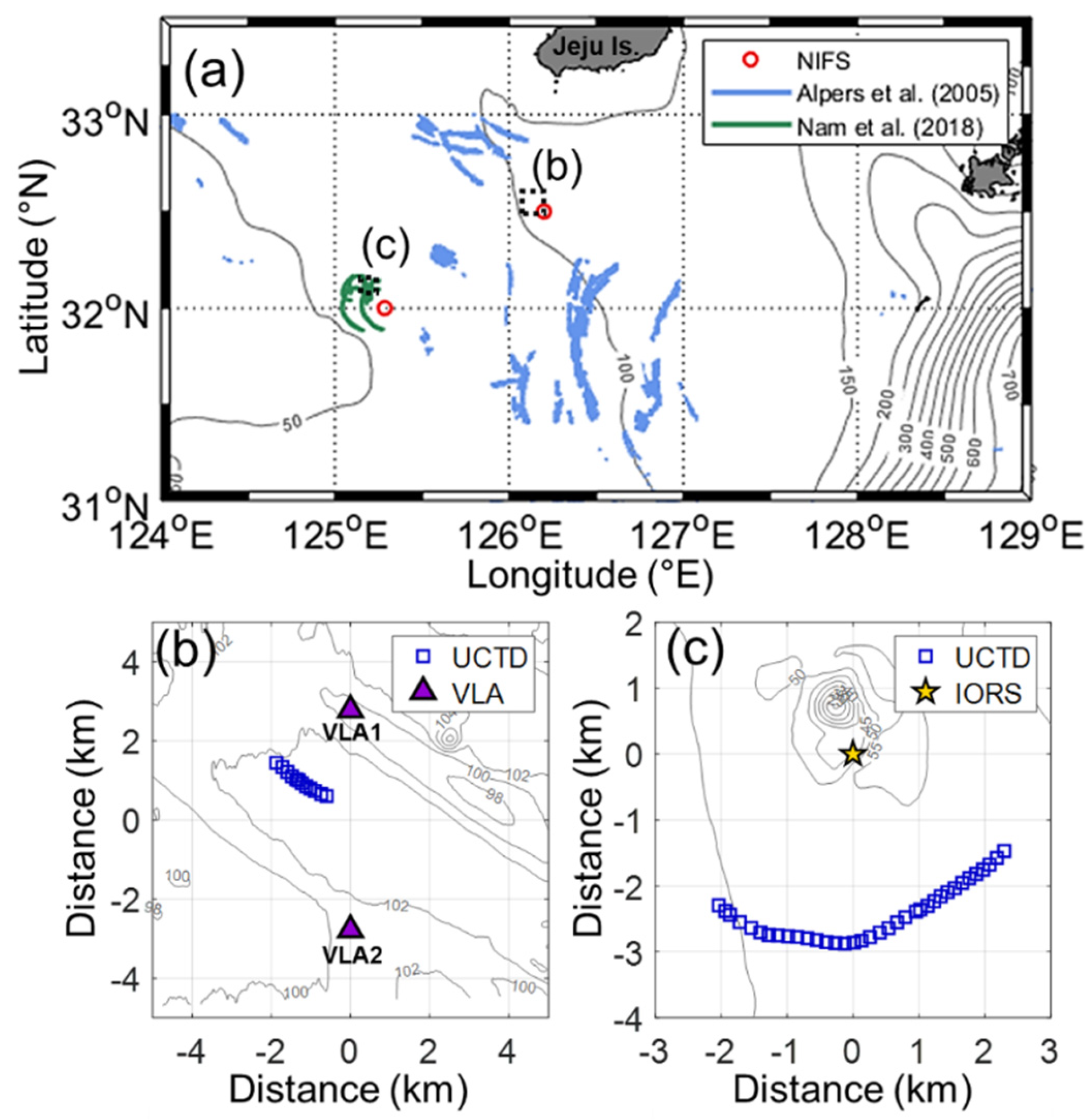


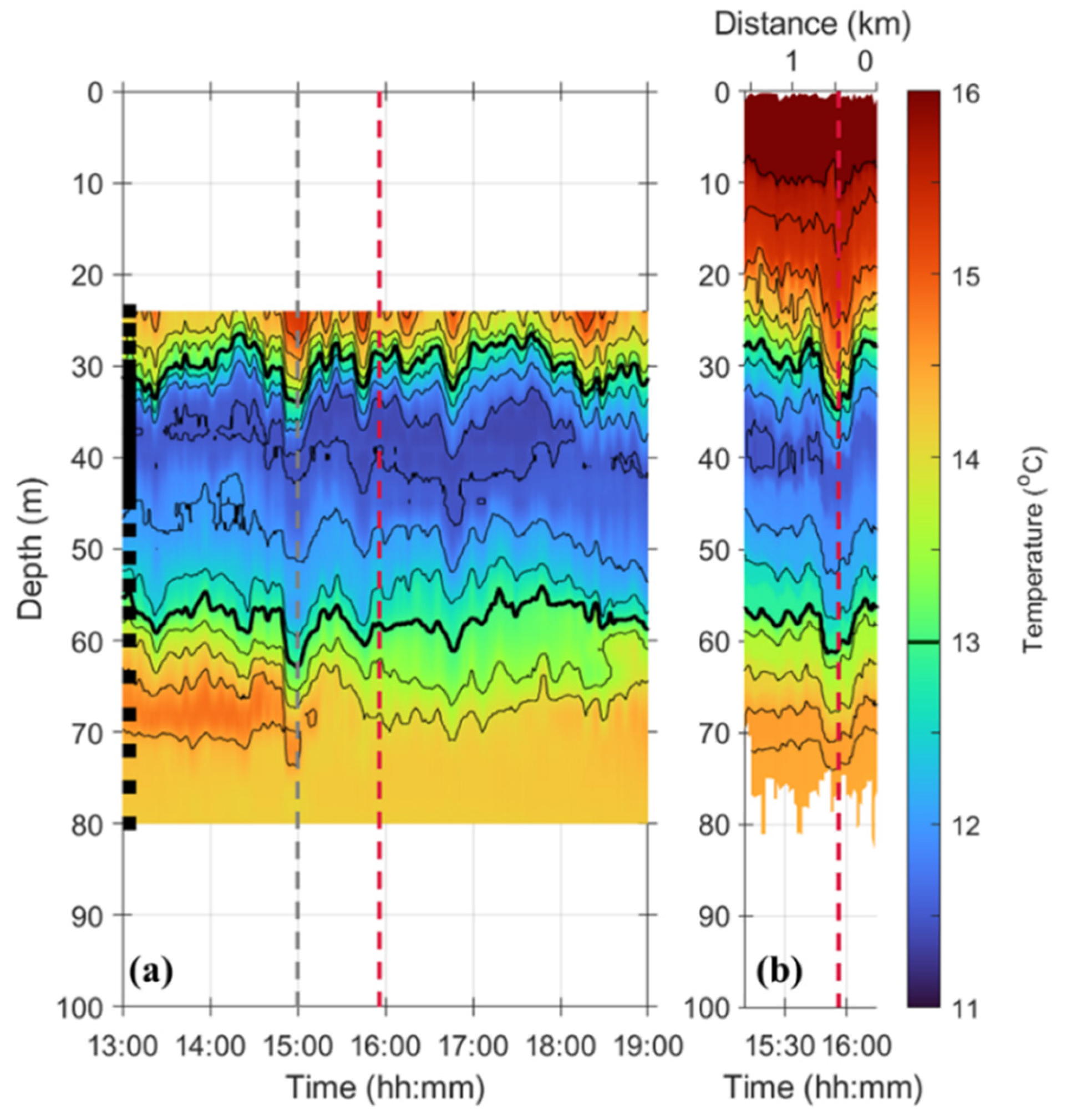
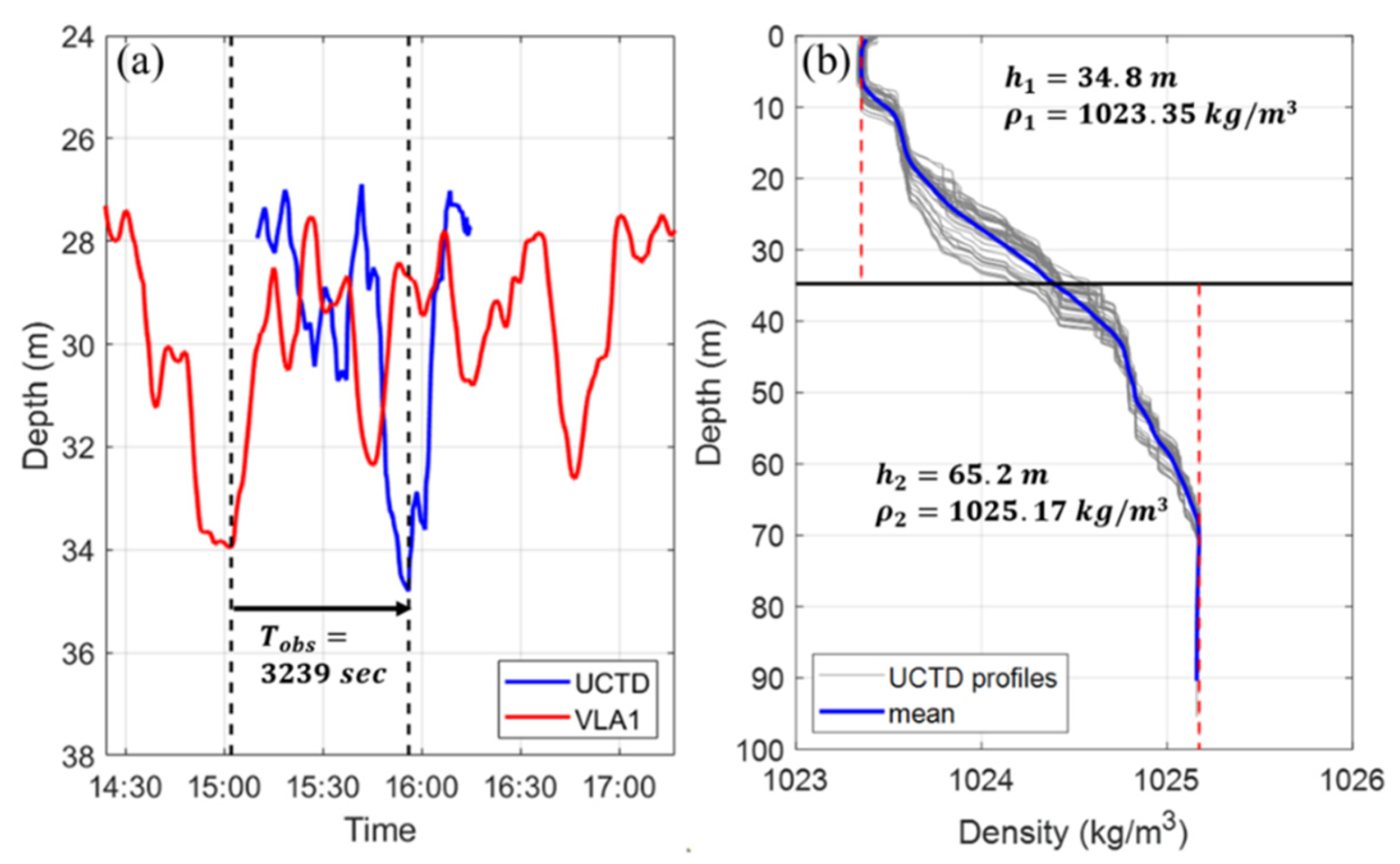
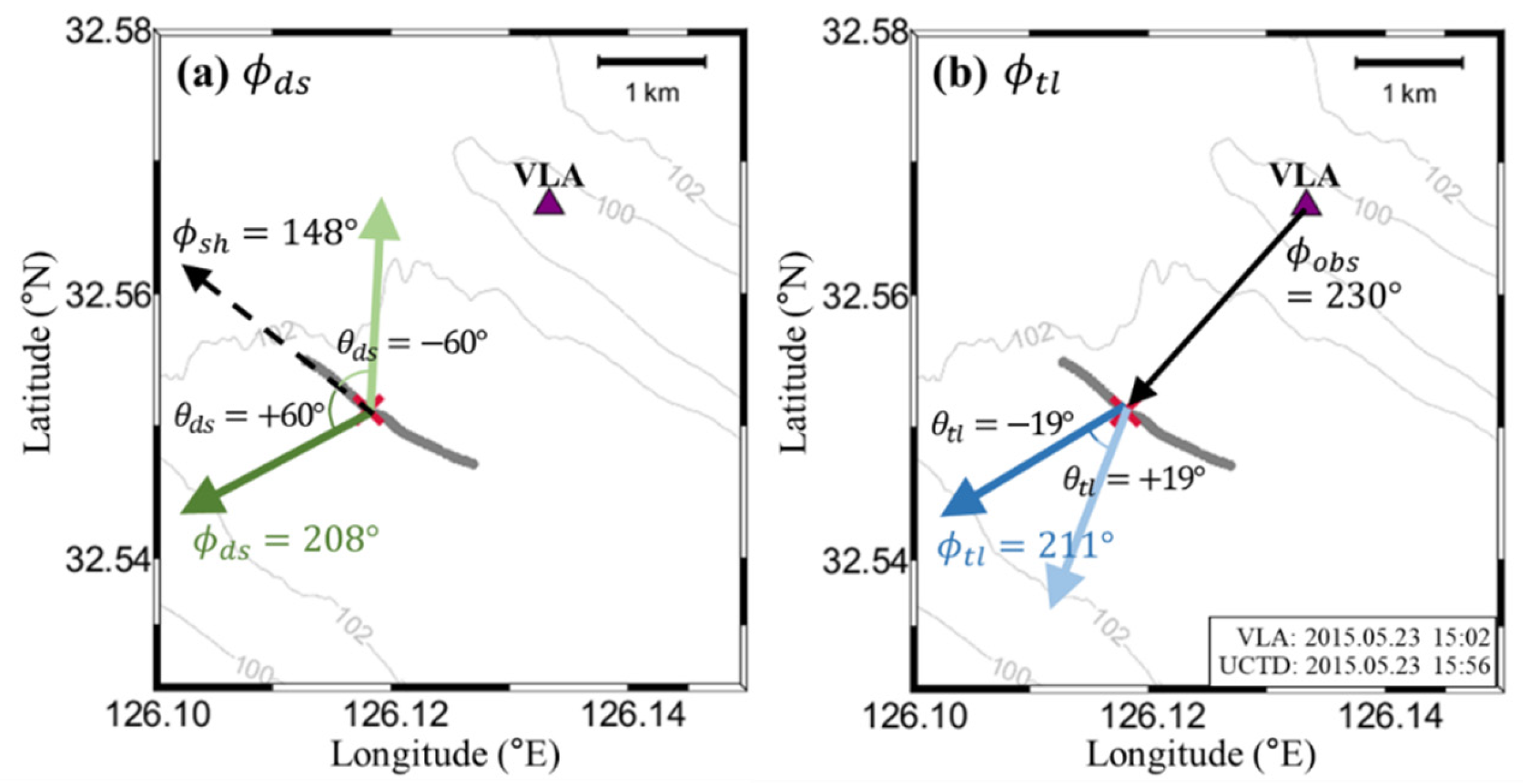

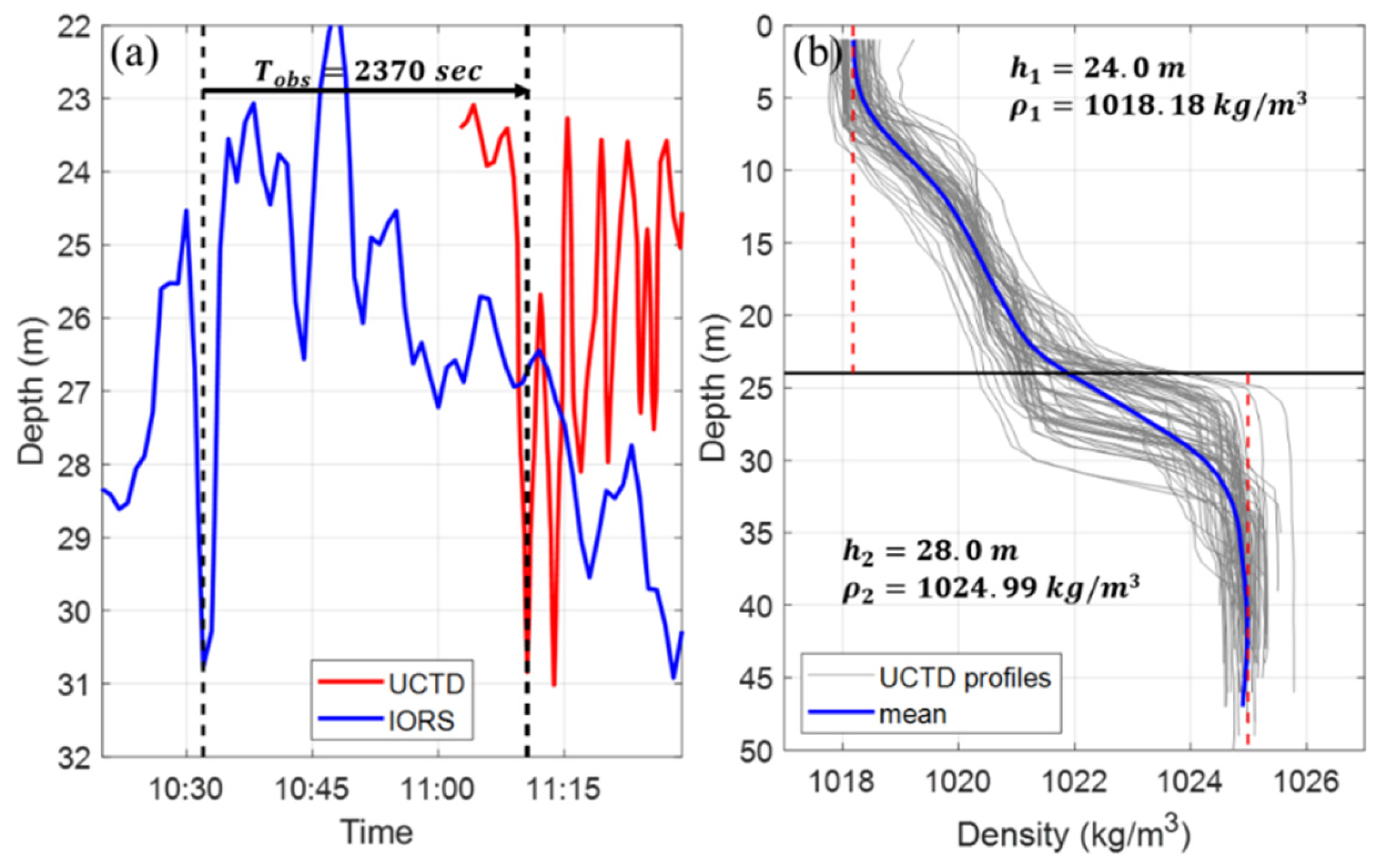


| Parameters | SAVEX15 | IORS18 | |
|---|---|---|---|
| Observation | |||
| Upper layer density | 1023.35 | 1018.18 | |
| Lower layer density | 1025.17 | 1024.99 | |
| Upper layer thickness | 34.8 | 24.0 | |
| Lower layer thickness | 65.2 | 28.0 | |
| Wave amplitude | 6.1 | 7.0 | |
| Wave apparent period | 1695 | 237 | |
| Ship course | 148 | 334 | |
| Ship speed | 0.47 | 1.38 | |
| Time lag between two different observations | 3239 | 2370 | |
| Distance between two different observations | 2233 | 3045 | |
| Speed between two different observations | 0.69 | 1.29 | |
| Angle between two different observations | 230 | 243 | |
| Estimation base on KdV and eKdV theory | |||
| Nonlinear parameter | −0.0127 | −0.0041 | |
| Cubic nonlinear parameter | −0.0009 | −0.0011 | |
| Dispersion parameter | 238 | 104 | |
| Linear phase speed | 0.63 | 0.92 | |
| Propagating speed based on KdV theory | 0.65 | 0.93 | |
| Propagating speed based on eKdV theory | 0.65 | 0.92 | |
| Characteristic width based on KdV theory | 384 | 416 | |
| Characteristic width based on eKdV theory | 432 | 1182 | |
| Wavelength based on KdV theory | 712 | 772 | |
| Wavelength based on eKdV theory | 802 | 2192 | |
| Estimation based on proposed methods (KdV theory) | |||
| 60 | 126 | ||
| NLIW propagating direction from Doppler shift | 208 | 208 | |
| 19 | 45 | ||
| NLIW propagating direction from time lag | 211 | 198 | |
| Optimal NLIW propagating speed | 0.64 | 1.06 | |
| Optimal NLIW propagating direction | 210 | 205 | |
| Estimation based on proposed methods (eKdV theory) | |||
| 68 | 100 | ||
| NLIW propagating direction from Doppler shift | 215 | 235 | |
| 18 | 46 | ||
| NLIW propagating direction from time lag | 212 | 197 | |
| Optimal NLIW propagating speed | 0.66 | 1.30 | |
| Optimal NLIW propagating direction | 213 | 234 | |
Publisher’s Note: MDPI stays neutral with regard to jurisdictional claims in published maps and institutional affiliations. |
© 2021 by the authors. Licensee MDPI, Basel, Switzerland. This article is an open access article distributed under the terms and conditions of the Creative Commons Attribution (CC BY) license (https://creativecommons.org/licenses/by/4.0/).
Share and Cite
Lee, S.-W.; Nam, S. Estimation of Propagation Speed and Direction of Nonlinear Internal Waves from Underway and Moored Measurements. J. Mar. Sci. Eng. 2021, 9, 1089. https://doi.org/10.3390/jmse9101089
Lee S-W, Nam S. Estimation of Propagation Speed and Direction of Nonlinear Internal Waves from Underway and Moored Measurements. Journal of Marine Science and Engineering. 2021; 9(10):1089. https://doi.org/10.3390/jmse9101089
Chicago/Turabian StyleLee, Seung-Woo, and Sunghyun Nam. 2021. "Estimation of Propagation Speed and Direction of Nonlinear Internal Waves from Underway and Moored Measurements" Journal of Marine Science and Engineering 9, no. 10: 1089. https://doi.org/10.3390/jmse9101089
APA StyleLee, S.-W., & Nam, S. (2021). Estimation of Propagation Speed and Direction of Nonlinear Internal Waves from Underway and Moored Measurements. Journal of Marine Science and Engineering, 9(10), 1089. https://doi.org/10.3390/jmse9101089







